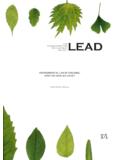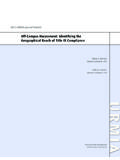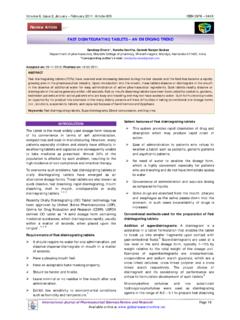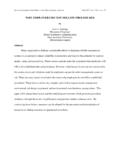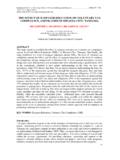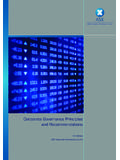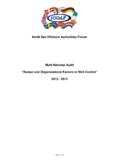Transcription of Law Environment and DevelopmentJournal - lead …
1 LEADLawEnvironment andDevelopmentJournalVOLUME3/1 ENVIRONMENTAL REGULATION IN UGANDA:SUCCESSES AND CHALLENGESC hristine Echookit AkelloLEAD journal (Law, Environment and development journal )is a peer-reviewed academic publication based in New Delhi and London and jointly managed by theSchool of Law, School of Oriental and African Studies (SOAS) - University of Londonand the International Environmental Law Research Centre (IELRC).LEAD is published at 1746-5893 The Managing Editor, LEAD journal , c/o International Environmental Law Research Centre (IELRC), International EnvironmentHouse II, 1F, 7 Chemin de Balexert, 1219 Ch telaine-Geneva, Switzerland, Tel/fax: + 41 (0)22 79 72 623, document can be cited as Environmental Regulation in Uganda: Successes and Challenges ,3/1 Law, Environment and development journal (2007), p.
2 20,available at REGULATION IN UGANDA:SUCCESSES AND CHALLENGESC hristine Echookit AkelloChristine Echookit Akello, Senior Legal Counsel, National Environment Management Authority, P O Box 22255 Kampala Uganda, 256-41-251064/5/8, under a Creative Commons Attribution-NonCommercial-NoDerivs LicenseTABLE OF National Environmental Action Plan (NEAP) and the NationalEnvironment Management Policy (NEMP) Framework for Environmental 1995 Constitution of Framework Environmental Law and its Linkages toSectoral and Challenges of Regulatory Provisions of the FrameworkEnvironmental and Recommendations25 INTRODUCTIONThis paper discusses environmental regulation inUganda: Successes and Challenges.
3 The policyframework, the constitution, the frameworkenvironmental law, various sectoral environmental lawsand regulations, provide a framework for environmentalregulation in Uganda. More than ten years since theframework law was enacted, the country has facednumerous challenges but has also registered somesuccesses. I shall here below outline policy considerationsthat informed the law and then discuss a few provisionsof the framework law and the sectoral laws that wereharmonised with the framework law. I will also discussthe successes and challenges in environmental regulation,using a few The National EnvironmentalAction Plan (NEAP) and the NationalEnvironment Management Policy(NEMP)Between 1991 to 1994 the Government of Ugandadeveloped a National Environment Action Plan(NEAP).
4 1 The NEAP provided a framework foraddressing gaps in Environment management as well asa strategy for integrating Environment into the nationalsocio-economic of the outcomes ofthe NEAP was the formulation of the NationalEnvironment Management Policy (NEMP) of overall Goal of the NEMP is sustainable social andeconomic development which maintains or enhancesenvironmental quality and resource productivity on along term-basis that meets the needs of the presentgenerations without compromising the ability of futuregenerations to meet their own needs. This policy goalhas informed subsequent policies such as the 2004/5-2007/8 Poverty Eradication Action Plan (PEAP) andthe Plan for the Modernisation of Agriculture (PMA).
5 The Policy provides strategies to guide and assistdecision makers and resource users in determiningpriorities in the national context and also at the sectoral,private sector and individual level. It provides forintegration of environmental concerns in national socio-economic development planning process, avenues forinter-sectoral cooperation, and comprehensive andcoordinated environmental management. As a result,environmental management is now a key criteria fornational socio-economic development Policy also recognised the need for sectoral policiesin addressing the specific concerns of the identifiedenvironmental sectors. It therefore provided aframework under which several sectoral policies weredeveloped.
6 These include the 1995 Water Policy, the1996 National Wetlands Management Policy, the 1996 Wildlife Policy, the 2000 Fisheries Policy, the 2001 Forestry Policy and several district environmentmanagement policies from 2000 addition, the policy provided a basis for theformulation of a comprehensive environmental legalframework under the 1995 Constitution and the NationalEnvironment also provided a framework formulti-sectoral approaches to resource planning andmanagement of natural resources. These approachesfound expression in the various environmental anddevelopment policies and in legislation such as theUganda Wildlife Act,4 the Water Act,5 the Land Act,6the National Forestry and Tree Planting Act,7 , Environment and development Journal221 National Environment Action Plan (NEAP) will be reviewedafter every five years or less.
7 See section 17(1) of the NationalEnvironment Act, Cap. 153, Laws of Uganda-2000 (UgandaLaw Reform Commission).2 See National Environment Act, note 1 above, section 18 (2)(a).3 See National Environment Act, note 1 Uganda, Uganda Wildlife Act (1996), Cap. 200, Laws ofUganda - 2000 edition (Uganda Law Reform Commission).5 Uganda, Water Act, , Laws of Uganda - 2000 edition(Uganda Law Reform Commission).6 Uganda, Land Act, Cap. 227, Laws of Uganda (Uganda LawReform Commission).7 Uganda, National Forestry and Tree Planting Act (hereafterForest Act), Laws of Uganda (Uganda Law ReformCommission).2 LEGAL FRAMEWORK FOR ENVIRO-NMENTAL REGULATIONThe laws discussed below have continued to promotethe concept of conservation of natural resources andsustainable development .
8 This section will briefly discussthe successes and challenges in the use of a fewenvironmental regulatory The 1995 Constitution ofUgandaThe constitution has provisions for enhancingconservation and management of the Environment andnatural resources. Objective XIII of the NationalObjectives and Directive Principles of State Policy andarticle 237(2)(b) of the constitution pronounce thepublic trust content and scope of thisdoctrine is being tested in the Government efforts tostudy possible change of land use for parts of theCentral Forest Reserves comprised in Mabira Forest andBugala Island in Kalangala district. It is envisaged thatin the near future a public interest action may be filed inthe courts to define this doctrine and the role of thestate as public constitution also enshrines a constitutional right toa clean and healthy Environment in its article 39.
9 Civilsociety has used article 50 of the constitution to enforcethis right using public interest The framework environmentallaw and its linkages to sectorallegislationThe National Environment Act,9 enacted in 1995, is theframework law on Environment . It provides forsustainable management of the Environment andestablished the National Environment ManagementAuthority (hereafter referred to as NEMA) as theprincipal government agency for the management of theenvironment. NEMA is mandated to coordinate, monitorand supervise all activities in the field of the framework law had the impact of triggeringamendment, enactment and harmonization of sectorallaws on Environment .
10 The affected laws include theNational Forestry and Tree Planting Act10 with aprovision on EIA; the Land Act11under which all ownersand occupiers of land are to manage it in accordancewith the National Forestry and Tree Planting Act, theMining Act, the National Environment Act, the WaterAct, the Uganda Wildlife Act, the Town and CountryPlanning Act12 and any other law; the Investment CodeAct13section 19(1)(d) of which makes it an implied termand condition of every holder of an investment licenseto take necessary steps to ensure that the operation oftheir business enterprise does not cause any injury tothe ecology or the Environment ; the Uganda WildlifeAct14sections 15 and 16 of which provide for EIA,audits and monitoring of projects that may have animpact on wildlife; the Mining Act,15sections 108 to 112of which require EIA, environmental audit,environmental protection standards, environmentalrestoration plans and environmental performance bondsin accordance with the National Environment Act.

